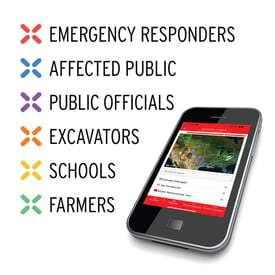
“It's just an evolution of taking all that data, putting it into the system, getting it to all the utilities who then get it to their subcontractors, trusted partners, and the gas, power, and water companies, and then maybe in five years, to the homeowner who can see where the lines are. We’ve got to get the utilities to start installing this now.” It was a simple statement made at the Global Safety Excavation Conference in Tampa earlier this year from a respected member of our industry who is also a “recovering locator” responsible for a large local distribution company's damage prevention program.
His comments were made during a panel discussion of industry leaders who were discussing whether a reduction in damages is possible and what it will take by all stakeholders to begin moving the needle. The panel was in unanimous agreement that technology will advance aspects of locating and mapping for the damage prevention community in ways that will ultimately assist with reducing damages.
During the question and answer portion of the Town Hall, a respected industry representative shared his version of the potential evolution of mapping and data availability. He offered that as easily as data can be shared by the gas company with its subcontractors, it can just as easily be shared with other trusted partners. Then comes another short jump in maybe five years to the ability to provide homeowners with a picture of their home and where the lines are so they can be more aware.
The response to him, and those attending was simple: Everything he discussed was indeed possible – now.
No one has to wait until tomorrow, much less for five years for the ability to customize data and provide it to any stakeholder, even at the homeowner level. The technology is already here and being used today by operators throughout the country.
This general concept is not new. Nearly a decade ago, operators pined for the ability to provide maps to landowners and public stakeholders as part of their public awareness efforts. And while it was possible, it came at a tremendous cost, and with numerous obstacles related to planning and implementation. Because of these hurdles, few ever attempted it, until the fall of 2021 when Buxus™ launched.
The concept for the mobile app is simple: Provide specific, targeted information to key stakeholders using a device that more than 85 percent of Americans don’t leave home without – their mobile phones. Initially, the app was to deploy integrated industry and operator-specific mapping and information to the response community. However, since it launched, the scope and purpose have evolved in ways never dreamed of because of the advancement of technology.
Historically, pipeline and utility operators depended on sending out a minimum of four brochures – one for each stakeholder group – to meet basic requirements. Some pipeline and utility operators expand their outreach by sending stakeholders a plethora of customized brochures delineated by product or pipeline. At the extreme end of this strategy, some operators deploy nearly 100 brochure variations to provide more specific information to stakeholders. Just imagine the time, cost, and environmental impact of this type of outreach that can be avoided due to technology. What once consumed hundreds of hours of preparation and precious resources can now be done via technology with the touch of a button.
People are hungry for information on their terms through their accepted channel(s) of communication. Using a single app that doesn't require Wi-Fi or cellular service, an operator can easily and quickly provide useful and upto- date stakeholder-specific information.
Giving people what they want and need in our technological world is not hard. Unfortunately some folks are adverse to change and/ or don't like to think outside of the box. Albert Einstein said that “the definition of insanity is doing the same thing over and over again, but expecting different results.” There is currently no reason to keep repeating the same methodologies because technology now allows for providing customized information, mapping, documents, and other resources to easily and efficiently reach targeted stakeholders.
“Technology is creating opportunities to advance safety, communicate more effectively, and seamlessly integrate compliance activities.”
Operators can now offer a unique user experience to their stakeholders in a way that fits their needs via an integrated and flexible solution that can be changed or updated in seconds. And to take it one step further, Buxus™ provides for an established two-way communication system which is the pinnacle of any stakeholder engagement program.
Now, homeowners, emergency responders, or public officials (to name just a few stakeholder groups) can log in and find out instantly about the various utilities and underground infrastructure that subscribe to the system. Because the operator controls the data each stakeholder sees, information may look different from one utility to the other; however, it is all available and can be shared today.
Just think about the amount of information and the ability to deploy vital safety information, all at the touch of a button and also having the ability to update that information in seconds.
This is progress. This is a game-changer. It is also a more cost effective, more modern method of communication, and a direct way for stakeholders to engage with operators more effectively.
Like the evolution of any technology, Buxus™ is now constantly advancing at a speed that is staggering. Just imagine the possibilities given what we have been able to do in the emergency response, public awareness, and stakeholder engagement space.
Those in the computer sciences will likely tell you that the evolution of technology has advanced more in the last six months than it has in the last 30 years and will open the door to limitless possibilities to improve damage prevention, stakeholder engagement, and nearly any other activity that can improve safety.

![ESM Sidebar Ad[87] ESM Sidebar Ad[87]](https://excavationsafetyalliance.com/hubfs/ESM%20Sidebar%20Ad%5B87%5D.gif)



Comments